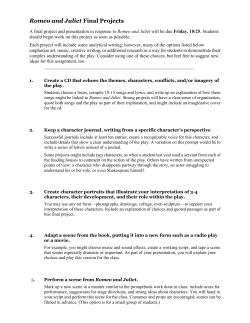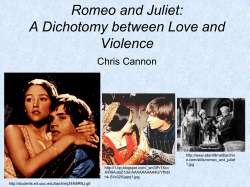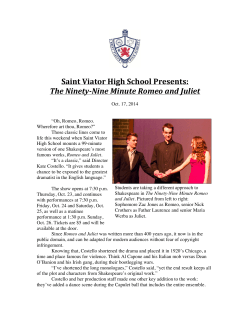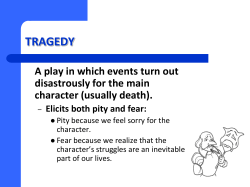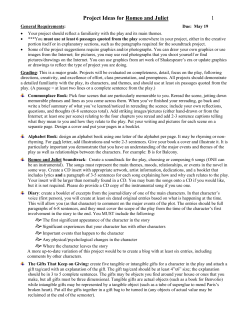
Romeo & Juliet - Lions Den Community
Romeo & Juliet Act II Prologue: Act II begins with another Prologue in the form of a _____________________ which provides the audience with a preview of what is to come. It states that the shallow love that Romeo had for Rosaline has been replaced with love for Juliet. What does “Alike bewitched by the charm of looks” express? Act II, Scene i 1. Where does Mercutio think Romeo has gone? ____________________________ 2. Why did Benvolio think Romeo would be mad about what Mercutio said in Line 17-21? ___________________________________________________________ _________________________________________________________________ 3. Mercutio ridicules people who are in love. Do you share his views, or do you think that he might be hiding his own feelings about love? Discuss in your groups. Come up with an answer to present. Act II Scene ii Directions: Put the following events in order from 1 (first event) to 10 (last event) _____Romeo at last speaks and they share the distress of the feud between their families. _____Juliet warns him of the dangers should he be discovered in the garden. _____After another brief absence, Juliet comes back and they arrange a time for Juliet’s messenger to be sent to him the following day. _____From a hidden position, he listens to Juliet. _____With the approach of dawn, they reluctantly part. _____Romeo steals into Juliet’s garden without being seen. _____He hears her declaring her love for him and her sadness that family rivalries should come between them. _____These worries are interrupted by the nurse’s call, at which point Juliet says she will be back in a few minutes. _____On her return, Juliet asks Romeo to send word the next day, if he intends to marry her. _____When she asks Romeo if he loves her, he openly declares his great love, but Juliet is worried by the suddenness of their strong feelings for each other. (Adopted by Collie & Slater, 1987) Directions: Answer the following questions in complete sentences. 1. Quote, restate and explain Romeo’s metaphor involving Juliet. 2. In Scene II, the play begins to explore the meaning of identity. Explain how. 3. When Juliet speaks about “light love” or her “light” behavior, what does she mean by the word “light”? 4. What “stony” limits, besides the orchard wall, separate the young lovers? How do they dismiss these obstacles? 5. What troubles Juliet about the arrangement she makes with Romeo? Directions: Jot down any words or phrases that best describe Romeo and Juliet from Act 1 to Act II, Scene ii. ROMEO JULIET Romeo & Juliet Balcony Imagery Directions: In pairs, listen and/or read Act II, Scene ii and listen for figurative language. I. Sun: 1. Jot down any references to the sun II. Moon: 1. Jot down any references to the moon III. Boldness: 1. Jot down things said which show Romeo or Juliet being bold IV. Reticent: 1. Jot down things said which show Romeo or Juliet being reticent V. Religious Imagery: 1. Jot down religious imagery used by Romeo or Juliet VI. Fear/Apprehension: 1. Jot own expressions of fear or apprehension spoken by Romeo or Juliet VII. Metaphors: 1. Jot down any metaphors or comparisons from nature, that is, flowers, birds, etc., by Romeo or Juliet Romeo & Juliet Act II Scene iii Look up the following vocabulary words: (notes in text or dictionary) Baleful: Virtues: Brine: Rancour: Vice: 1. In addition to describing the qualities and dangers of herbs, Friar Laurence also compares these qualities to those in humans. What is the main idea of his soliloquy? 3. Lines 23-26: Friar Laurence is speaking of a particular flower: a. If it is smelled, what does it do? b. If it is tasted, what does it do? 4. Why does the Friar claim Romeo is fickle? 5. Why, in view of his opinion regarding Romeo’s feelings, does the Friar agree to marry Romeo and Juliet? Romeo & Juliet Act II Scenes iv-vi Directions: Answer the following questions in complete sentences. 1. Mercutio calls Tybalt “more than Prince of Cats,” a reference to a character in an animal story. In what ways is Tybalt more dangerous than the fictional “Prince of Cats”? What might this image foreshadow? 2. What is the setting of Scene v? What effect does juxtaposing these short, varied scenes have on the drama? 3. What is Shakespeare’s purpose in the delaying tactics of the Nurse? 4. How do Romeo and the Friar’s viewpoints on love differ? 5. What does the Friar’s warning against the intensity of their feelings foreshadow? Romeo & Juliet Act Two Notes I. Shakespeare and His Times William Shakespeare (1564-1616) was born to a fairly wealthy, prominent family in Stratford-on-Avon during the reign of Queen Elizabeth I. He was the third of eight children and lived the expected life for a child of his social standing, attending primary or “petty” school and then a Latin grammar school. At age eighteen, Shakespeare wed Anne Hathaway, a woman six years his senior. The couple had three children: Susanna, and twins Judith and Hamnet. Little is known about Shakespeare’s life between the years of 1585 and 1592, but it is known that Shakespeare traveled to London some time between the ages of eighteen and twenty-eight and joined the theater. He debuted as a playwright with his first performance in 1590. Shakespeare’s world was a very different one from that of today, and the differences are reflected clearly in his plays. For example, children in Shakespeare’s day had no rights except those allowed by their parents. Teenagers had to obey their parents’ every whim until they married. Marriages were commonly arranged by the parents for purposes other than love and affection between the parties involved. Daughters married young for the most part, often as early as fourteen or fifteen years of age. A father had a God-given obligation to choose a husband for his daughter who would be able to support her materially and protect her physically. The father’s right was not contingent upon the daughter’s agreement or approval, though certainly a father would want his daughter to be happy as well as provided for. Wives, just like children, were obliged to obey their husbands. These cultural tenets—pushed to extremes for dramatic purposes—can be witnessed in Romeo and Juliet. Other ideas of the time that are evidenced in Romeo and Juliet are that of courtly love and Petrarchan conceit. Courtly love is a code and philosophy of love that flourished first in France and later in England and other countries. According to this philosophy, falling in love was by necessity accompanied by extreme emotional distress—helplessness, confusion, agitation, sleeplessness, loss of appetite, and a general agony over the situation. The lover engages in interminable reflections on the nature of love and his own part in the state. This code is seen clearly in Romeo’s afflicted state of being in love with Rosaline. Petrarchan conceit was a type of conceit—an overblown, almost ridiculous metaphor comparing two almost irreconcilably different things—used by Petrarch in his Italian love sonnets. Conceits are characterized by the use of oxymoron and paradox. Romeo utilizes this in his descriptions of his forlorn state to his friends. Romeo & Juliet Act Two Journal Journals demonstrate your ability to write on a subject with voice and choice (infusing personality, reflecting on the topic, and writing in a way that is vivid); of course, you must also provide support from the text. An average length for a journal entry is two paragraphs. Act II Journal Topic: Imagine that you are Romeo & Juliet, and that you are facing the problem that they are dealing with: forbidden love. However, instead of eloping and angering their parents, you decide to tackle this problem in a different way. In one paragraph, propose a different storyline for this play. Provide a synopsis of how the rest of the story would play out. Provide a rationale for your suggested alternate ending (it needn’t be a happy ending, although it may be). _____________________________________________________________________ _____________________________________________________________________ _____________________________________________________________________ _____________________________________________________________________ _____________________________________________________________________ _____________________________________________________________________ _____________________________________________________________________ _____________________________________________________________________ _____________________________________________________________________ _____________________________________________________________________ _____________________________________________________________________ _____________________________________________________________________ _____________________________________________________________________ _____________________________________________________________________ _____________________________________________________________________ _____________________________________________________________________ _____________________________________________________________________ _____________________________________________________________________ _____________________________________________________________________ _____________________________________________________________________ _____________________________________________________________________ _____________________________________________________________________ _____________________________________________________________________ _____________________________________________________________________ _____________________________________________________________________ _____________________________________________________________________ _____________________________________________________________________
© Copyright 2025
